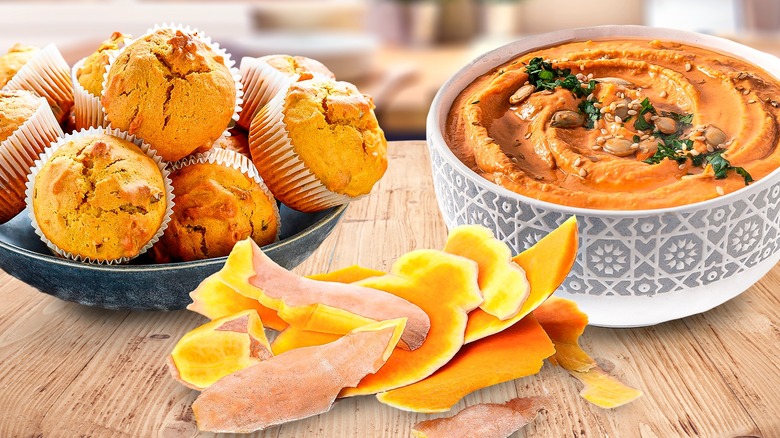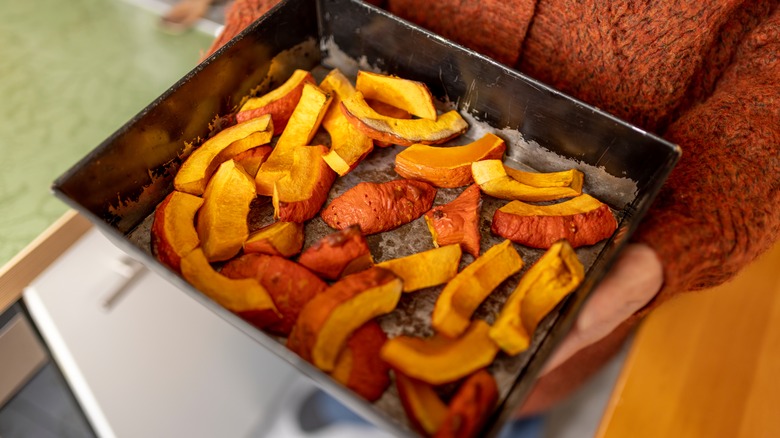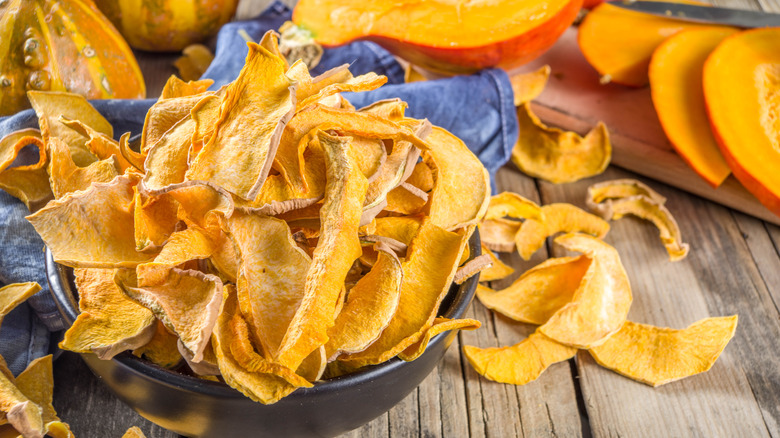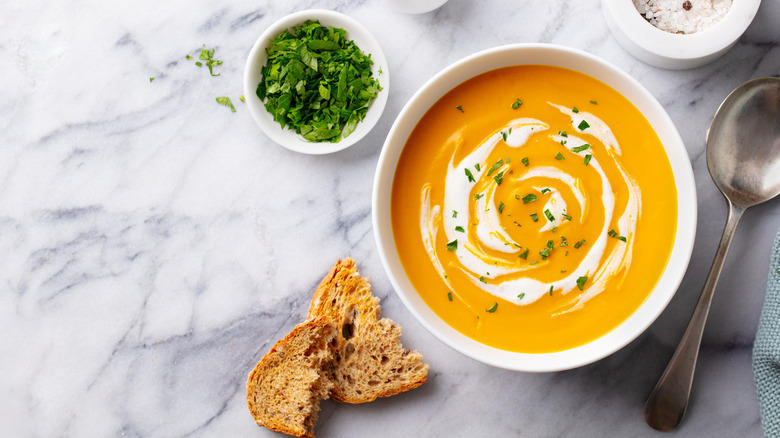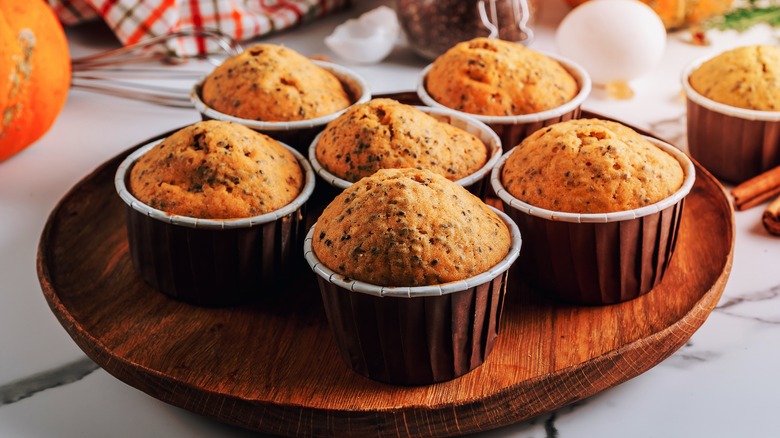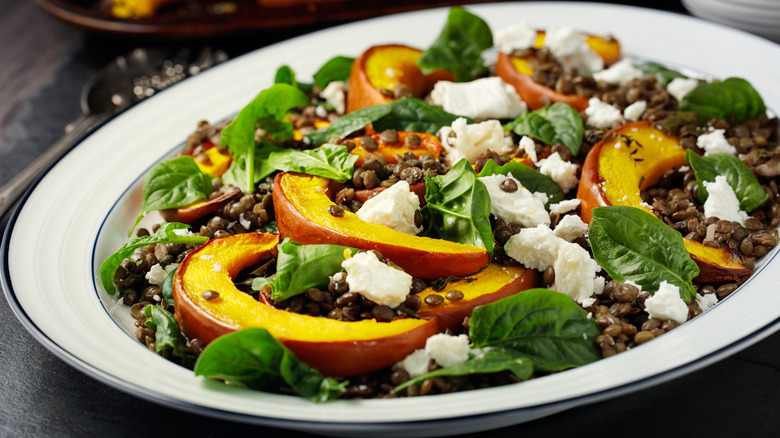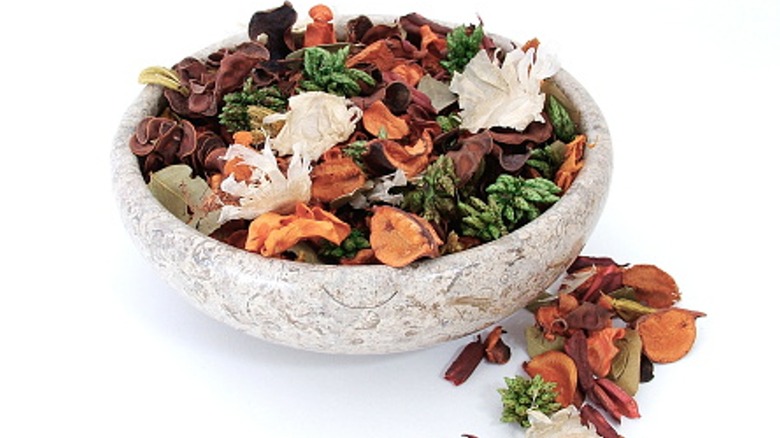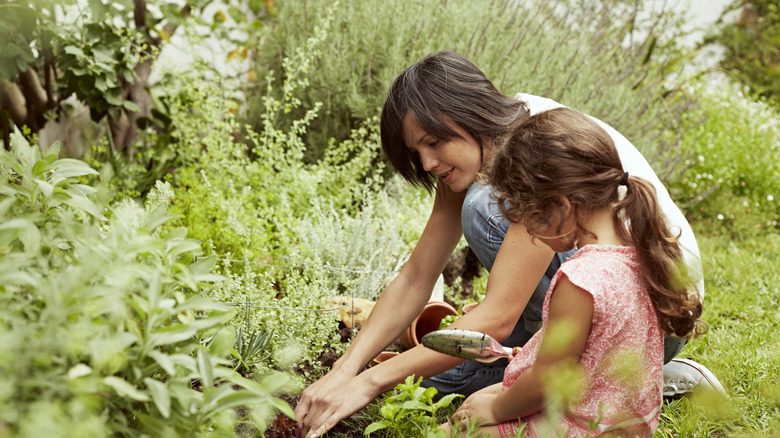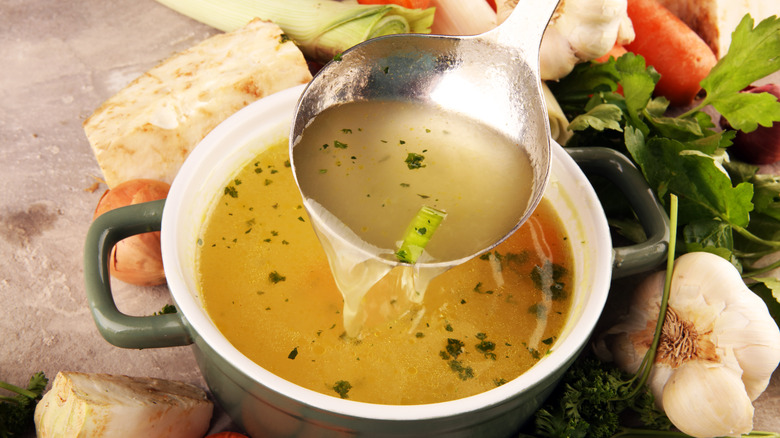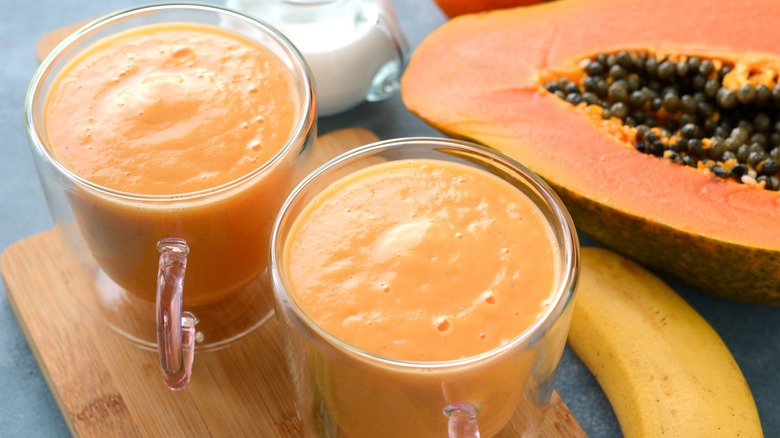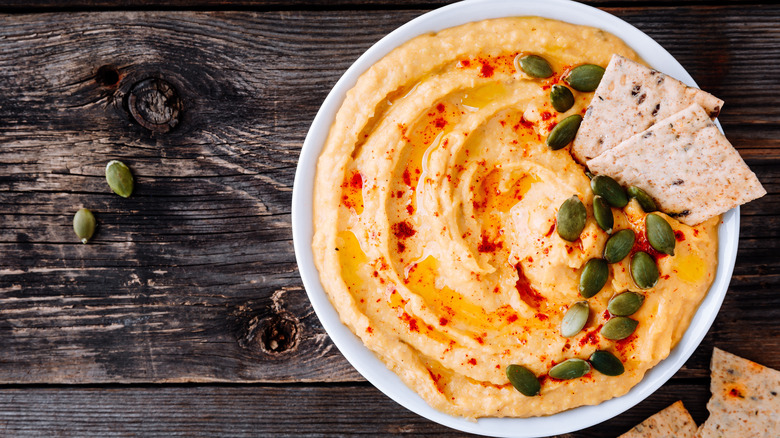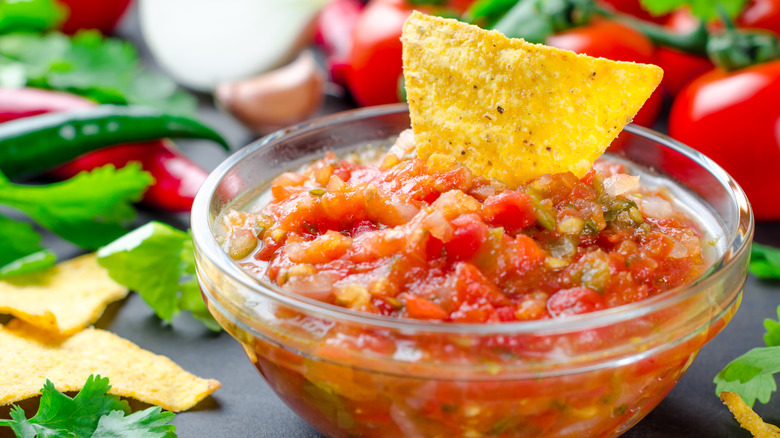12 Creative Ways To Use Pumpkin Peels
Fall cooking wouldn't be complete without the comforting aroma of pumpkin wafting through the kitchen. Whether you're indulging in classics like pumpkin pie and pumpkin bread or venturing into more adventurous territory with pumpkin tiramisu and pumpkin spice cake pops, there's no shortage of ways to savor this autumn staple. Yet, amidst all the culinary excitement, one often-overlooked element lingers in the background: pumpkin peels.
Since they're historically brushed off as being inedible, pumpkin peels routinely find themselves discarded — destined for the compost bin without a second thought. It's high time we challenged this long-standing notion and reconsidered the potential of pumpkin peels in our culinary endeavors. We're here to guide you on a journey of discovery and present creative uses for pumpkin peels. From crafting savory snacks and canine treats to elevating the flavors of fall salads and soups, these neglected treasures offer a wealth of untapped possibilities. Embrace an open mind, and you'll soon realize that pumpkin peels are a hidden gem, ready to contribute unique flavors, bright colors, and satisfying textures to all of your favorite dishes.
Keep them on while roasting
One of the simplest ways to use pumpkin peels is to leave them on while roasting your wedges. You might even enjoy the extra fiber and additional toasty flavor of your gourd. Putting this tip into action is simple. Instead of cutting the skin off as you normally would, slice the pumpkin into wedges and massage it with olive oil and herbs (chopped garlic and fresh rosemary is a winning combination) before tossing it onto a baking sheet, covering it, and roasting it.
While this suggestion is easy to implement, there are a couple of caveats to be aware of. First of all, because you'll be eating the skin, it's a smart idea to look for organic pumpkins. The skin is the part of the plant most exposed to pesticides, so you're better off avoiding conventionally grown pumpkins if possible. Something else to keep in mind is that not all pumpkin skins are created equal. You probably won't want to eat the skin of your Jack-O-Lantern. It's hard, thick, and won't soften — no matter how much time it spends in the oven. Instead, look for types of pumpkin and squash with more tender flesh, such as the Hokkaido pumpkin or red kuri squash.
Pumpkin skin transforms into pumpkin chips
We love potato chips, but sometimes we can't help but feel like they're a bit ... basic. Nowadays, you can buy (or make) plantain chips, kale chips, and even parsnip chips, so why limit yourself? Take this as a sign to experiment with pumpkin skin chips. Start by choosing your preferred type of pumpkin and cooking method. We recommend pie pumpkins (also called sugar pumpkins) for their thin, edible skins. The air fryer and the oven are the two primary cooking methods for this veggie-forward snack.
Once you've laid the groundwork, the next step is cooking. Cut the pumpkin into small pieces and either air fry it or roast it in the oven. Whichever method you choose, the goal is to be able to separate the skin from the flesh easily. Remove the skin with a knife or a peeler and cut it into bite-sized pieces. Next, cover it with olive oil and seasonings. Salt and pepper always work, but don't be afraid to experiment with a combination of warming spices (nutmeg, cinnamon, and ginger), pizza herbs (basil, oregano, rosemary, parsley, thyme, and garlic powder), or just some smoked paprika. From there, air fry or bake again. You'll know the chips are done when they take on an orangey-brown color and crisp texture.
Cook them into soup
If you've ever prepared pumpkin soup, like curried roasted pumpkin and lentil soup, you're likely familiar with the traditional method of roasting the pumpkin, scooping out the flesh, and combining it with sautéed alliums before blending. While this approach works perfectly fine, we're excited to introduce an alternative that minimizes waste. Fortunately, this technique is straightforward. After roasting the pumpkin pieces as usual, add the pumpkin (including the peel) to the pot along with the other ingredients. Once everything is well combined, blend the mixture and garnish it with your preferred toppings.
Leaving the pumpkin peels on not only reduces waste but also infuses the soup with extra fiber, protein, and minerals such as calcium and magnesium. Moreover, the peels help thicken the soup and may impart additional roasted flavors to the palate. If you're concerned about the texture, rest assured — roasting softens the peel, and blending ensures it fully incorporates into the soup.
Give your dog a treat
Sometimes, we treat our dogs like a walking compost bin. Perhaps you've shared your unwanted sandwich crusts or tossed your furry friend some discarded fruit peels. Our intention isn't to criticize or make you feel embarrassed. Instead, we want to highlight our mutually beneficial relationship with our canine companions. You get to dispose of food scraps, and your four-legged pal receives a tasty treat — a true win-win situation.
Let's take that idea and expand your pooch's culinary repertoire by preparing some homemade pumpkin skin dog treats. While preparing your preferred pumpkin dish, slice away the peel and arrange it skin-side-down on a baking sheet. Bake until the skin dries out and the edges start to curl, keeping in mind that a longer baking time results in a chewier texture. Be sure to allow the skins to cool before offering them to your dog, and store any leftover pieces in an airtight container for up to one week. This recipe is about as easy as it gets, but make sure you opt for thin-skinned gourds like pie pumpkins, Hokkaido pumpkins, or butternut squash to avoid potential digestive issues for your furry friend.
Add them to scones or muffins
While we passionately promote the use of pumpkin peels, we understand that many will find it challenging to embrace the idea. In most cases, that hesitation stems from the preparation process. When incorrectly prepared, the texture of pumpkin peels becomes overly chewy, and the taste leans bitter. But it doesn't have to be like that. Once you've mastered the art of pumpkin peel preparation, you'll open the door to incorporating this delicious and nutritious ingredient into all of your favorite recipes.
As an example, pumpkin peels seamlessly enhance the flavor and richness of scones and muffins. To whip up pumpkin peel-infused baked goods, like delectable pumpkin streusel muffins, you'll need to swap your usual canned pumpkin purée for the fresh variety. Prepare it by roasting the pumpkin with the skin intact, then cut it into small pieces and use a food processor to blend everything into a smooth mixture. When the purée is ready, combine it with the flour, sugar, eggs, and spices to create the muffin batter. Sure, it takes a bit more work, but the tasty outcome is more than worth it.
Layer them on top of salads
Given pumpkin's strong association with autumn, you might find integrating roasted pumpkin into a summery salad unconventional. However, that's precisely what we're suggesting. When paired with the right ingredients, roasted pumpkin provides heft, complexity, and a subtle nuttiness to every salad it touches.
For the best results, choose a smaller pumpkin variety, such as a pie pumpkin. You'll also want to make sure the skin is free of bumps and blemishes. Not only will they ruin your dish's presentation, but they will also make your pumpkin rot faster than normal. Prepare the pumpkin by cutting it into bite-sized wedges and covering it with olive oil and salt. Roast in the oven until the flesh softens and the peel starts to curl at the edges. Once the wedges have cooled, arrange them on your favorite bed of greens, mixing in seasonal delights like pepitas, dried cranberries, and crumbled goat cheese. If you're looking for additional autumnal inspiration, turn to ingredients like pomegranate seeds, toasted nuts, and tangy blue cheese.
Dry pumpkin peels for potpourri
The appeal of freshly baked pumpkin pie or a steaming pumpkin spice latte is undeniable. However, transforming your space into a haven of autumnal coziness doesn't necessarily require having to cook something — at least to eat. You can effortlessly infuse the warm, comforting scent of fall into your surroundings by repurposing pumpkin peels into delightful potpourri. It only takes a few simple steps and uses minimal ingredients.
Start by cutting the pumpkin into ½-inch wedges and removing the seeds. While many recipes recommend smaller, sweeter pumpkins, any type will work here. After all, we're after the fragrance, not the taste. Dip the pumpkin wedges in lemon juice to preserve their bright orange color, then generously sprinkle both sides with pumpkin spice. You can use either a store-bought blend or make your own by combining equal amounts of cinnamon, nutmeg, ground ginger, and ground cloves. Now, dry the pumpkin pieces, preferably with a dehydrator or using your regular oven. Check on them periodically and remove them once they're dry and crispy. Finish by displaying them in a bowl or making pouches using cheesecloth. Scatter them around your home, and voilà: instant fall vibes!
Scatter them in your garden
The compost bin is a common destination for your pumpkin peels. But we should probably clarify that that's not such a bad way to dispose of them. Pumpkin peels break down quickly, turning into potassium and magnesium-rich fertilizers right before your eyes. These minerals promote plant growth, enrich the soil, and maintain optimal moisture levels, especially in dry conditions. To prepare the peels for composting, remove any seeds or residue and chop them into small pieces to speed up the decomposition process.
But don't limit yourself to composting. There's another way to put pumpkin peels to good use in your garden. Just wash and cut them, then place them directly into the soil around your plants. As they break down, they'll release nutrients, improve soil aeration, and encourage plant growth. And there's a bonus: Positioning pumpkin peels at the base of your plants acts as a natural pest control method. Thanks to the bitter compound cucurbitacin, the peels repel pests like aphids, cucumber beetles, and squash bugs.
Boil them into stock
Juggling a full-time job, coordinating family schedules, squeezing in a workout, and trying to find a moment to relax can leave you with little enthusiasm for cooking from scratch. We hear you, and we're right there with you. However, if you happen to find an extra burst of energy and want to elevate your dishes, consider preparing pumpkin peel stock. The process isn't too complicated, and the depth of flavor it gives to dishes like pumpkin risotto and Moroccan pumpkin stew is more than worth the effort.
To prepare it, combine pumpkin peels, leftover pumpkin pieces, water, and onion (or onion trimmings) in a pot. You can also toss in other vegetable scraps and peels you have on hand, but no stress if you're just working with the basics. Cover the pot and simmer. Allow it to cool, then use a fine mesh sieve to separate the solids from the flavorful liquid. You can incorporate this liquid into all your favorite autumn recipes. Any leftovers can be stored in an airtight container in the fridge for a week or frozen for up to a year.
Toss them into a smoothie
From coconut to berries, there are all kinds of ingredients you can add to make smoothies more refreshing. But there's one ingredient you're guaranteed to be sleeping on: pumpkin peels. While they may seem like an unconventional addition, pumpkin peels meld seamlessly with ingredients like pumpkin purée, frozen banana, and pumpkin pie spice to create uniquely refreshing pumpkin smoothies.
To incorporate pumpkin peels into your smoothie adventure, start by making homemade pumpkin purée, leaving the peel on. The roasting and blending process for the purée will naturally soften the peel, making it easy to blend into your drink. After preparing and cooling the purée, blend it with the aforementioned ingredients, adding milk and sweeteners like brown sugar. Keep in mind that the final smoothie may be a bit thicker and more bitter due to the peel, so adjust the amount of milk and sugar as needed.
Purée them into hummus
As an autumnal culinary star, you'll find pumpkin in everything from donuts to ravioli. With its incredible versatility, there's no limit to your pumpkin experiments. Begin your flavorful journey with our easy and delightful roasted garlic pumpkin hummus. While the original recipe skips on pumpkin peels, don't hesitate to add them — they seamlessly blend into the mix.
Craft this fall-inspired spread by using a food processor to blend homemade skin-on pumpkin purée with roasted garlic, chickpeas, olive oil, tahini, maple syrup, and spices. Enjoy the velvety result with crackers, raw veggies, or pita bread. You can add it to burgers or paninis for a full meal. Any hesitations about adding pumpkin peels can be forgotten. They undergo a double blending process, eliminating any chewy bits or bitterness. Plus, pumpkin peels are brimming with B vitamins, calcium, and magnesium, making this a healthy snack you'll want to prepare again and again.
Chop them into salsa
Unless you've spent a significant amount of time in Mexico, your understanding of salsa might be limited to the jar of Old El Paso that's been sitting in your fridge for months. There's no shame in indulging in the store-bought variety now and then, but other types of salsa are out there waiting to be explored. Consider salsa verde, a green, tomatillo-based sauce. Or how about salsa ranchera, a boiled salsa served atop enchiladas? Although not a traditional recipe, pumpkin salsa is yet another unique salsa to add to your repertoire.
Since you'll be keeping the peel on for this recipe, we recommend using Hokkaido pumpkin. This variety is praised for its edible skin and mild, slightly sweet taste. Dice the pumpkin and fry it with alliums and spicy peppers. Add a sweetener, lime juice, and stock, then bring to a boil. Finish by puréeing the mixture and adding cubed tomatoes for extra chunkiness. Enjoy it as a snack with tortilla chips, or use it to dress up burritos or quesadillas.
Static Media owns and operates Tasting Table and Mashed.
